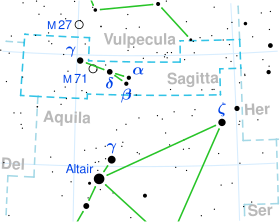Theta Sagittae
Theta Sagittae (θ Sagittae) is a double star in the northern constellation of Sagitta.[14] With a combined apparent visual magnitude of +6, it is near the limit of stars that can be seen with the naked eye. According to the Bortle scale the star is visible in dark suburban/rural skies. Based upon an annual parallax shift of 22.15 mas as seen from Earth,[15] it is located roughly 147 light years from the Sun.
The binary pair consists of two stars separated by 502 AU.[16] The primary, component A,[17] is an F-type main sequence star with a stellar classification of F3V.[4] This star is about two billion years old[9] with 52% more mass than the Sun.[9] It forms a double star with a magnitude 8.85 companion,[17] which is located at an angular separation of 11.58 arc seconds along a position angle of 331.1°, as of 2011.[14] The star is sometimes described as a triple star, with a 7th magnitude companion 91″ away.[17] This is an unrelated giant star much further away than the close pair.[18] A fainter star separated by nearly 3′ was also listed as a companion by Struve,[17] again just an accidental optical association.[19]
References
- ^ a b c d e f g h Brown, A. G. A.; et al. (Gaia collaboration) (August 2018). "Gaia Data Release 2: Summary of the contents and survey properties". Astronomy & Astrophysics. 616. A1. arXiv:1804.09365. Bibcode:2018A&A...616A...1G. doi:10.1051/0004-6361/201833051. Gaia DR2 record for this source at VizieR.
- ^ a b c Høg, E.; Fabricius, C.; Makarov, V. V.; Urban, S.; Corbin, T.; Wycoff, G.; Bastian, U.; Schwekendiek, P.; Wicenec, A. (2000), "The Tycho-2 catalogue of the 2.5 million brightest stars", Astronomy and Astrophysics, 355: L27, Bibcode:2000A&A...355L..27H.
- ^ a b c d e f g h Brown, A. G. A.; et al. (Gaia collaboration) (August 2018). "Gaia Data Release 2: Summary of the contents and survey properties". Astronomy & Astrophysics. 616. A1. arXiv:1804.09365. Bibcode:2018A&A...616A...1G. doi:10.1051/0004-6361/201833051. Gaia DR2 record for this source at VizieR.
- ^ a b Abt, H. A. (September 1985), "Visual multiples. VIII. 1000 MK types", Astrophysical Journal Supplement Series, 59: 95–112, Bibcode:1985ApJS...59...95A, doi:10.1086/191064.
- ^ a b Hoffleit, Dorrit; Jaschek, Carlos (1991), "The Bright star catalogue", New Haven, Bibcode:1991bsc..book.....H.
- ^ Adams, Walter S.; et al. (April 1935), "The Spectroscopic Absolute Magnitudes and Parallaxes of 4179 Stars", Astrophysical Journal, 81: 187, Bibcode:1935ApJ....81..187A, doi:10.1086/143628.
- ^ a b Anderson, E.; Francis, Ch. (2012), "XHIP: An extended hipparcos compilation", Astronomy Letters, 38 (5): 331, arXiv:1108.4971, Bibcode:2012AstL...38..331A, doi:10.1134/S1063773712050015, S2CID 119257644.
- ^ a b Casagrande, L.; et al. (2011), "New constraints on the chemical evolution of the solar neighbourhood and Galactic disc(s). Improved astrophysical parameters for the Geneva-Copenhagen Survey", Astronomy & Astrophysics, 530 (A138): 21, arXiv:1103.4651, Bibcode:2011A&A...530A.138C, doi:10.1051/0004-6361/201016276, S2CID 56118016.
- ^ a b c d e f David, Trevor J.; Hillenbrand, Lynne A. (2015), "The Ages of Early-Type Stars: Strömgren Photometric Methods Calibrated, Validated, Tested, and Applied to Hosts and Prospective Hosts of Directly Imaged Exoplanets", The Astrophysical Journal, 804 (2): 146, arXiv:1501.03154, Bibcode:2015ApJ...804..146D, doi:10.1088/0004-637X/804/2/146, S2CID 33401607.
- ^ do Nascimento, J. D. Jr.; et al. (July 2003), "On the link between rotation, chromospheric activity and Li abundance in subgiant stars", Astronomy and Astrophysics, 405 (2): 723–731, arXiv:astro-ph/0307196, Bibcode:2003A&A...405..723D, doi:10.1051/0004-6361:20030633, S2CID 1106754.
- ^ Allende Prieto, C.; Lambert, D. L. (1999), "Fundamental parameters of nearby stars from the comparison with evolutionary calculations: Masses, radii and effective temperatures", Astronomy and Astrophysics, 352: 555–562, arXiv:astro-ph/9911002, Bibcode:1999A&A...352..555A.
- ^ McDonald, I.; Zijlstra, A. A.; Watson, R. A. (2017), "Fundamental parameters and infrared excesses of Tycho–Gaia stars", Monthly Notices of the Royal Astronomical Society, 471 (1): 770–791, arXiv:1706.02208, Bibcode:2017MNRAS.471..770M, doi:10.1093/mnras/stx1433.
- ^ "tet Sge". SIMBAD. Centre de données astronomiques de Strasbourg. Retrieved 2017-07-10.
{{cite web}}: CS1 maint: postscript (link) - ^ a b Mason, Brian D.; et al. (May 2012), "Speckle Interferometry at the U.S. Naval Observatory. XVIII", The Astronomical Journal, 143 (5): 6, Bibcode:2012AJ....143..124M, doi:10.1088/0004-6256/143/5/124, 124, archived from the original on June 13, 2017.
- ^ van Leeuwen, F. (2007), "Validation of the new Hipparcos reduction", Astronomy and Astrophysics, 474 (2): 653–664, arXiv:0708.1752, Bibcode:2007A&A...474..653V, doi:10.1051/0004-6361:20078357, S2CID 18759600.
- ^ Halbwachs, J.-L.; et al. (May 2012), "Double stars with wide separations in the AGK3 - I. Components that are themselves spectroscopic binaries", Monthly Notices of the Royal Astronomical Society, 422 (1): 14–24, Bibcode:2012MNRAS.422...14H, doi:10.1111/j.1365-2966.2012.20308.x.
- ^ a b c d Mason, B. D.; et al. (2014), The Washington Visual Double Star Catalog, Bibcode:2001AJ....122.3466M, doi:10.1086/323920
- ^ Brown, A. G. A.; et al. (Gaia collaboration) (August 2018). "Gaia Data Release 2: Summary of the contents and survey properties". Astronomy & Astrophysics. 616. A1. arXiv:1804.09365. Bibcode:2018A&A...616A...1G. doi:10.1051/0004-6361/201833051. Gaia DR2 record for this source at VizieR.
- ^ Brown, A. G. A.; et al. (Gaia collaboration) (August 2018). "Gaia Data Release 2: Summary of the contents and survey properties". Astronomy & Astrophysics. 616. A1. arXiv:1804.09365. Bibcode:2018A&A...616A...1G. doi:10.1051/0004-6361/201833051. Gaia DR2 record for this source at VizieR.

